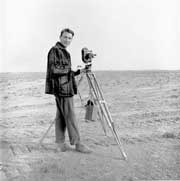 Ernest Lowe studied photography in the late 50's with the noted social documentarian, John Collier Jr. His other models were the classic images of Dorothea Lange, Walker Evans, and other Farm Security Administration photographers. These influences are reflected strongly in his work, which in some ways looks like a new page from the old FSA files. In 1959 Lowe joined the staff of Pacifica radio station KPFA and almost immediately began documenting the lives of migrant farm workers.
Ernest Lowe studied photography in the late 50's with the noted social documentarian, John Collier Jr. His other models were the classic images of Dorothea Lange, Walker Evans, and other Farm Security Administration photographers. These influences are reflected strongly in his work, which in some ways looks like a new page from the old FSA files. In 1959 Lowe joined the staff of Pacifica radio station KPFA and almost immediately began documenting the lives of migrant farm workers.“It was natural for me to combine interviewing for a radio documentary with photography,” Lowe recalled. “I'd just walk up to people in a camp or an orchard and say, ‘I hear you folks are getting a raw deal. I'd like to take your pictures and talk with you so people back in the city can do something about it.’” They very seldom turned him down. Many of these recorded interviews have survived. Working before conflict erupted, Lowe enjoyed access to vineyards, migrant camps and the inner workings of agribusiness that later photographers were denied. These early pictures also reveal the multi-racial face of migrant labor. Blacks, Anglos, Japanese and Filipinos are pictured, as well as Latinos.
At the end of the first year, Lowe showed his work to Dorothea Lange, who declared, “This is my family album,” and loaned the photographer a 35mm Contax and a gift to cover film and expenses. He traveled up and down the San Joaquin and Salinas Valleys in 1961, 1963, and 1966, documenting labor camps and shack towns and the grueling work in the rich fields and orchards.
In the fall of 1964, Lowe moved his family to the San Joaquin Valley and spent two months photographing and recording interviews in the unincorporated African-American community of Teviston. This was the first time anyone had documented any of the little known fourteen or more “Black Okie” settlements up and down the Central Valley. He also created iconic images of workers picking cotton, some of the last before the mechanical cotton picker displaced them.
In 2015 Lowe returned to two of the Black Okie communities to see if he could find any of the people he'd photographed. He reports the response in South Dos Palos, “At the first house I visited folks came out and started puzzling over my fifty-four year old photos. Soon the front yard was crowded with relatives from the neighborhood and they had named most of the kids in the photos I brought. Laughing about the time capsule I'd brought to them, they photographed my prints with phones and iPads and called distant relatives about their discovery.” In Teviston and Pixley he also found many of the youth he'd photographed in the 60s and their response was equally enthusiastic.
Captured mostly in medium format, Lowe's images are carefully composed, quiet moments, seemingly frozen in time. Lowe's people can be monumental—icons of migrant life—but the images are also respectful, intensely personal portraits. His work in the 60s culminated in a major multi-media exhibit at San Francisco's deYoung Museum. In 2013-14 the UC School of Journalism gallery hosted a show of his work focusing on farm worker children.
Since the sixties Lowe has worked in varied roles: producer-director in public tv, transpersonal counselor, peace and environmental activist, organizational and sustainable development consultant, and always, poet. He is currently "harvesting" his life at ernestlowe.com.